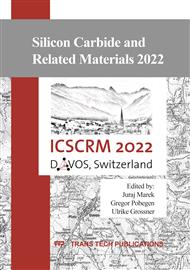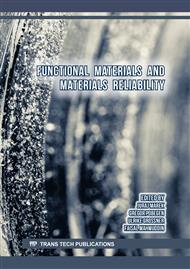[1]
Y. Ren et al., "A Compact Gate Control and Voltage-Balancing Circuit for Series-Connected SiC MOSFETs and Its Application in a DC Breaker," IEEE Transactions on Industrial Electronics, vol. 64, no. 10, pp.8299-8309, Oct. 2017.
DOI: 10.1109/tie.2017.2711579
Google Scholar
[2]
P. Salmen et al., "A new test procedure to realistically estimate end-of-life electrical parameter stability of SiC MOSFETs in switching operation," in 2021 IEEE International Reliability Physics Symposium (IRPS). IEEE, Mar. 2021.
DOI: 10.1109/irps46558.2021.9405207
Google Scholar
[3]
H. Jiang et al., "Dynamic gate stress induced threshold voltage drift of silicon carbide MOSFET," IEEE Electron Device Letters, vol. 41, no. 9, pp.1284-1287, Sep. 2020.
DOI: 10.1109/led.2020.3007626
Google Scholar
[4]
P. Salmen et al., "Gate-switching-stress test: Electrical parameter stability of SiC MOSFETs in switching operation," Microelectronics Reliability, vol. 135, p.114575, Aug. 2022.
DOI: 10.1016/j.microrel.2022.114575
Google Scholar
[5]
H. Jiang et al., "A physical explanation of threshold voltage drift of SiC MOSFET induced by gate switching," IEEE Transactions on Power Electronics, vol. 37, no. 8, pp.8830-8834, Aug. 2022.
DOI: 10.1109/tpel.2022.3161678
Google Scholar
[6]
C. Xu et al., "Impact of duty cycle and junction temperature on dynamic threshold drift of SiC MOSFET," in 2021 4th International Conference on Energy, Electrical and Power Engineering (CEEPE). IEEE, Apr. 2021.
DOI: 10.1109/ceepe51765.2021.9475706
Google Scholar
[7]
L. Tang et al., "The influence of dynamic threshold voltage drift on third quadrant characteristics of SiC MOSFET," in 2021 IEEE Workshop on Wide Bandgap Power Devices and Applications in Asia (WiPDA Asia). IEEE, Aug. 2021.
DOI: 10.1109/wipdaasia51810.2021.9656049
Google Scholar
[8]
X. Zhong et al., "Bias temperature instability of silicon carbide power MOSFET under AC gate stresses," IEEE Transactions on Power Electronics, vol. 37, no. 2, pp.1998-2008, Feb. 2022.
DOI: 10.1109/tpel.2021.3105272
Google Scholar
[9]
X. Zhong et al., "Gate stress polarity dependence of AC bias temperature instability in silicon carbide MOSFETs," IEEE Transactions on Electron Devices, vol. 69, no. 6, pp.3328-3333, Jun. 2022.
DOI: 10.1109/ted.2022.3164641
Google Scholar
[10]
A. K. Ghosh et al., "Studies of AC BTI stress in 4H SiC MOSFETs," in 2021 IEEE International Integrated Reliability Workshop (IIRW). IEEE, Oct. 2021.
DOI: 10.1109/iirw53245.2021.9635608
Google Scholar
[11]
A. K. Ghosh et al., "Comparison of AC and DC BTI in SiC power MOSFETs," in 2022 IEEE International Reliability Physics Symposium (IRPS). IEEE, Mar. 2022.
DOI: 10.1109/irps48227.2022.9764494
Google Scholar
[12]
K. Puschkarsky et al., "Understanding and modeling transient threshold voltage instabilities in SiC MOSFETs," in 2018 IEEE International Reliability Physics Symposium (IRPS). IEEE, Mar. 2018.
DOI: 10.1109/irps.2018.8353560
Google Scholar
[13]
K. Puschkarsky et al., "Threshold voltage hysteresis in SiC MOSFETs and its impact on circuit operation," in 2017 IEEE International Integrated Reliability Workshop (IIRW). IEEE, Oct. 2017.
DOI: 10.1109/iirw.2017.8361232
Google Scholar
[14]
T. Grasser et al., "CV stretch-out correction after bias temperature stress: Work-function dependence of donor-/acceptor-like traps, fixed charges, and fast states," in 2021 IEEE International Reliability Physics Symposium (IRPS). IEEE, Mar. 2021.
DOI: 10.1109/irps46558.2021.9405184
Google Scholar
[15]
R. Castagné et al., "Description of the SiO2-Si interface properties by means of very low frequency MOS capacitance measurements," Surface Science, vol. 28, no. 1, pp.157-193, Nov. 1971.
DOI: 10.1016/0039-6028(71)90092-6
Google Scholar
[16]
A. Salinaro et al., "Charge pumping measurements on differently passivated lateral 4H-SiC MOSFETs," IEEE Transactions on Electron Devices, vol. 62, no. 1, pp.155-163, Jan. 2015.
DOI: 10.1109/ted.2014.2372874
Google Scholar
[17]
M. W. Feil et al., "Optical emission correlated to bias temperature instability in SiC MOSFETs," in 2022 IEEE International Reliability Physics Symposium (IRPS). IEEE, Mar. 2022.
DOI: 10.1109/irps48227.2022.9764584
Google Scholar
[18]
L. Kimerling, "Recombination enhanced defect reactions," Solid-State Electronics, vol. 21, no. 11-12, pp.1391-1401, Nov. 1978.[19] J. D. Weeks et al., "Theory of recombination-enhanced defect reactions in semiconductors," Physical Review B, vol. 12, no. 8, pp.3286-3292, Oct. 1975.
DOI: 10.1016/0038-1101(78)90215-0
Google Scholar
[20]
H. Sumi, "Dynamic defect reactions induced by multiphonon nonradiative recombination of injected carriers at deep levels in semiconductors," Physical Review B, vol. 29, no. 8, pp.4616-4630, Apr. 1984.
DOI: 10.1103/physrevb.29.4616
Google Scholar
[21]
T. Grasser et al., "The 'permanent' component of NBTI: Composition and annealing," in 2011 International Reliability Physics Symposium (IRPS). IEEE, Apr. 2011.
Google Scholar
[22]
T. Grasser et al., "The mysterious bipolar bias temperature stress from the perspective of gatesided hydrogen release," in 2020 IEEE International Reliability Physics Symposium (IRPS). IEEE, Apr. 2020.
DOI: 10.1109/irps45951.2020.9129198
Google Scholar



